These turkeys were using a feeding strategy that was both new to me and highly entertaining.
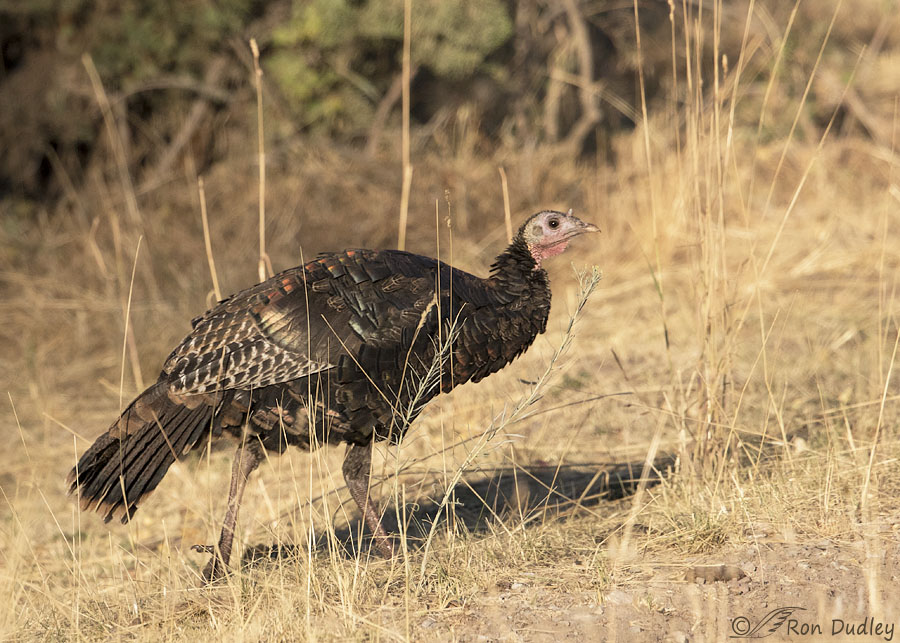
1/2000, f/6.3, ISO 800, Canon 7D Mark II, Canon EF 500mm f/4L IS II USM + EF 1.4 III Extender, not baited, set up or called in
Four days ago I encountered a flock of Wild Turkeys in one of the canyons of the Stansbury Mountains. All of them appeared to be hens or young of the year and unlike most turkeys I see they weren’t shy and reclusive as they mostly ignored the presence of my pickup.
I was able to get many photos of them but I chose to post this one for my introductory photo because most of the time they were either in the shade or on the dirt road. I prefer a more natural habitat in my photos and this grassy setting is typical of where I find them. In this case the grass in front of the bird doesn’t bother me and I like the light and the iridescent colors on the turkey.
But my primary motivation for publishing this post has very little to do with quality, appealing turkey photos. Instead I’m more interested in the unusual feeding behavior they exhibited and hopefully finding out from my readers what kind of berries or fruit they were feeding on. But sadly the documentary photos I have showing the behavior are of very poor quality for reasons that will soon become obvious so prepare yourselves for that.
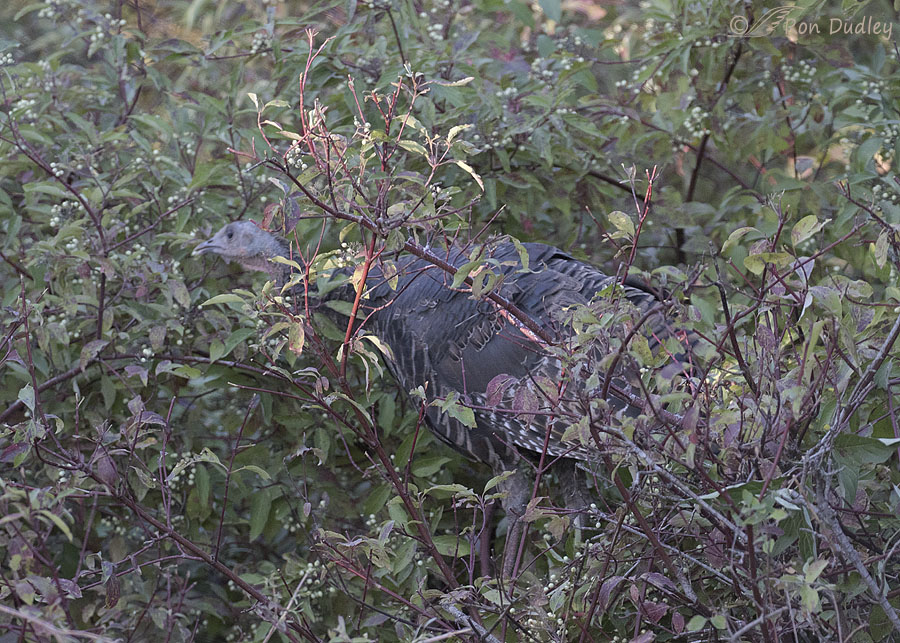
1/500, f/5.6, ISO 1600, Canon 7D Mark II, Canon EF 100-400mm f/4.5-5.6L IS II USM @ 271 mm, not baited, set up or called in
They were feeding in an extremely dense patch of berries near a creek and beneath a thick canopy of trees so they were in deep, deep shade. There was so little light it almost appeared to be night in there and once they were in the patch the vegetation usually covered them so completely I could only see where a bird was when it moved a little. The berries were small and in the shade they appeared to be near-white – hundreds of them can be seen in this photo and the turkey has one of them in its bill.
The problem they had was getting into the patch and at the berries in the first place. The vegetation was so thick that the very large birds couldn’t even come close to walking into it or through it to access the fruit so they employed a unique strategy that was effective but also dramatic, loud, amusing and seemingly out of control.
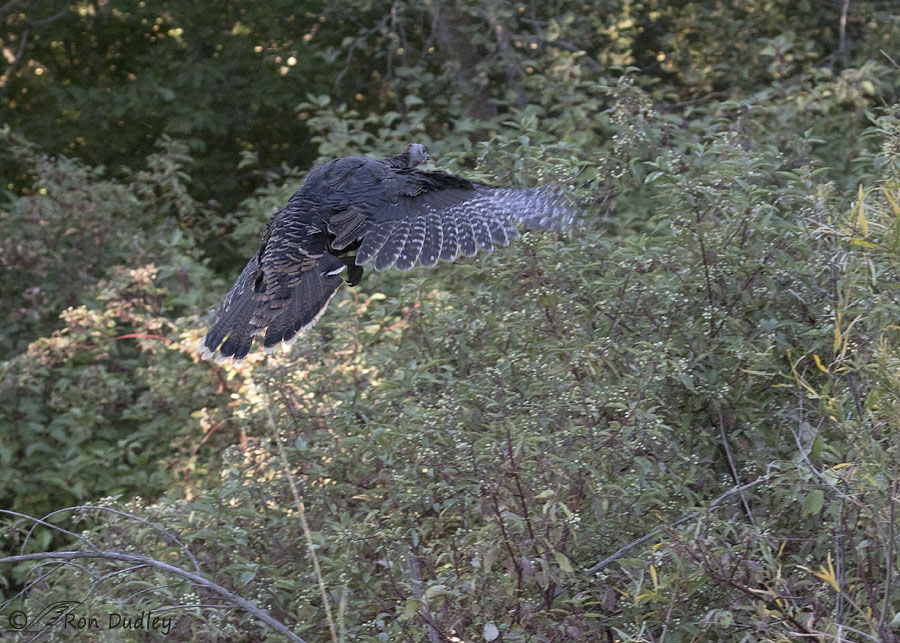
1/800, f/5.6, ISO 1600, Canon 7D Mark II, Canon EF 100-400mm f/4.5-5.6L IS II USM @ 117 mm, not baited, set up or called in
Each bird would take off from just a few feet away from the patch, fly above it and then…
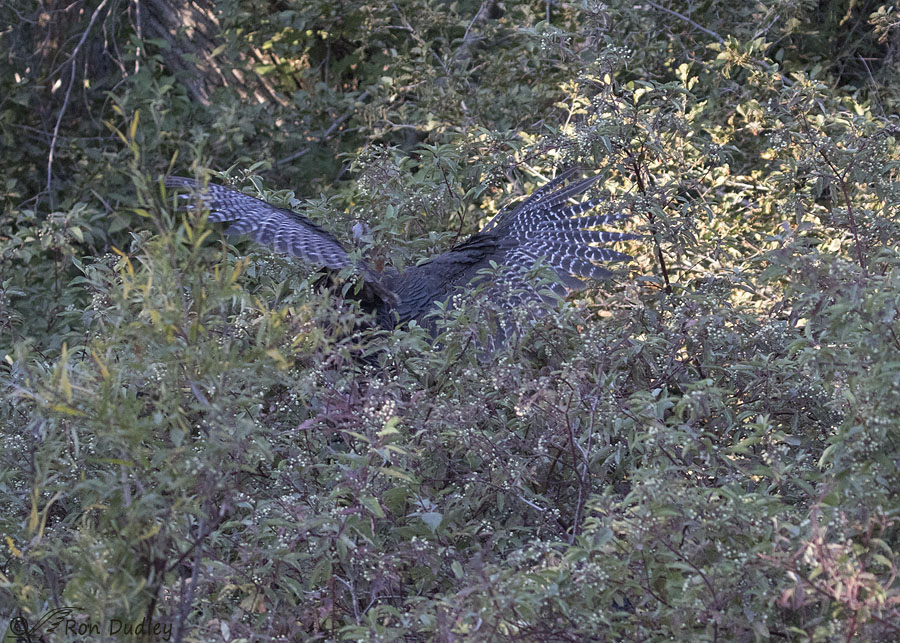
1/800, f/5.6, ISO 1600, Canon 7D Mark II, Canon EF 100-400mm f/4.5-5.6L IS II USM @ 117 mm, not baited, set up or called in
crash-land in the middle of the patch with its wings spread so the branches and leaves would break its fall. Once inside the patch I don’t believe they were usually perched on branches – instead it appeared to me like they were often standing on the ground and typically I couldn’t even see where they were because they were so covered in vegetation and the light was so poor.
And damn, did this process ever make a lot of noise! When several birds this large fly and crash-land in vegetation this thick or take off out of it the ‘whump, whump, whump’ of their wings against the vegetation almost sounds like a herd of elephants crashing through the brush.
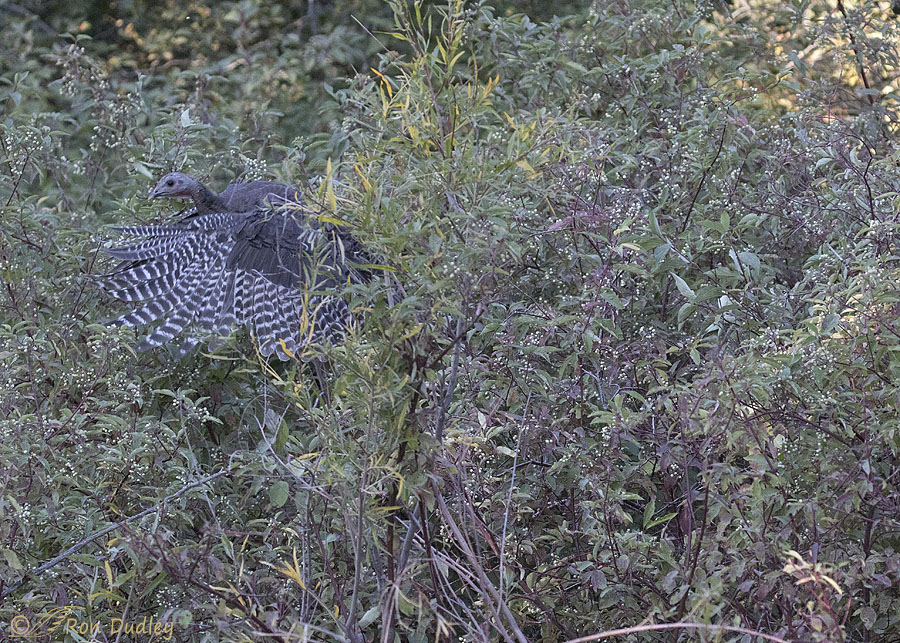
1/1250, f/5.6, ISO 2500, Canon 7D Mark II, Canon EF 100-400mm f/4.5-5.6L IS II USM @ 135 mm, not baited, set up or called in
And when they eventually took off out of the patch the process and the noise were repeated.
This happened again and again with many of the turkeys in the flock. The thought that kept going through my mind was “How do their feathers hold up over time with all the abuse they’re taking as their tails and wings in particular beat against all those vertical branches”? I would guess these turkeys spend a lot of time preening after a feeding session like this one.
The berries can probably be seen best in photo #2 and this one. I don’t recall seeing this kind of berry before so I’d appreciate an ID if any of my readers know what they are (photos taken at an elevation of 6400′ 4 days ago in Utah’s Stansbury Mountains.)
Ron


Hi Ron! I think what the birds are doing! They are using their weight and wings to push down the small branches so it is easier to get the berries? It looks like a white berry which will turn blue( we call a huckleberry) Blue berry are a larger berry! We had both in Michigan
Some of the berries in Florida ripen and turn to some sort of alcohol and the crows devour them, get drunk from the berries and fly eradically all over bumping into each other and become very vocal as if they were drunk from the berries. They fight each other to get those berries.
What a interesting day. The Turkey’s are beautiful in the sunlight. I like the last photo with the wing fanned out. Very nice.
Thank you, Jean.
Must be a pretty tough bird judging from your description and photos. I am really struck by the first photo; iridescence and habitat.
Let’s see: white berries, leaves opposite each other with dark green on top and pale underneath, red twigs, native to Utah…. Sure looks like Cornus sericea. I don’t see turkeys here but several other birds gobble them up (pun intended),
I think “tough birds” describes them well, Lyle.
How clever of them to work out a way to get to a food that they obviously prize. It would have been a hoot to watch as well. Is food in short supply for them at the moment or is there something special about these berries? And have any of your knowledgeable commentators ever tasted red osier dogwood for themselves? Like Marty I was wondering about ‘medicinal’.
EC, I’d think food for turkeys would be in good supply this time of year so they must have a real hankering for these berries, for whatever reason.
That is interesting pictures of the Wild Turkeys and flying in and out of bushes. I would have loved to see that in person.
Thank you, Trudy.
Interesting foraging technique. I have seen turkeys hop/climb to get to berries but not crash land. I was going to say the bush is what we use to call dogwood, but I don’t know the specific kind.
The crash landings were the fun part, April!
Based on comments on this post and at least one other on Facebook and a little of my own research I’m now fairly confident the plants and berries are red osier dogwood (Cornus sericea).
Ron, quite interesting photos and narrative. I would never have guesses that wild turkeys feed themselves using this method.
I can imagine the noise was almost deafening with the effort it took to get their food.
Thank you, Ron
They were certainly loud, Alice. Thanks.
Same here on Red Osier Dogwood, and as well, I know nothing about Utah habitat and growing conditions for this dogwood.
Love the pictures, enjoy the post, especially taking the images as they attempted to negotiate their food source.
Thanks for sharing.
Thank you, Dick. I’m beginning to see a trend on the ID opinions…
My first thought was Red Osier Dogwood, also, although I have not researched in regard to Utah habitat. Fascinating photos and description of behavior. I can readily imagine the sound.
Dogwood almost seems to be becoming a consensus, Linda. Thanks.
Very interesting behavior! The photo immediately following your warning made me laugh. I have an idea about your berries: Mountain Snowberry (Symphoricarpos oreophilmus). The whiteness of the berries reminded me of some we saw at the Jackson Point Overlook in Grand Teton National Park. Thanks to my husband, who remembered what year we were there, I was able to find the photos and the name. Not sure it’s the same bush, but the elevation and the area of the country are similar, as well as the color of the berries. I’ve never seen any berries that white before. The ones in my photo are probably about ½” long.
I’ll check on snowberry too. Thanks, Susan.
“Snowberries” we have here have a more rounded leaf shape and are a smaller bush tho it may be just here!
A most interesting way to feed! Looks like the turkeys didn’t realize their size…or perhaps they did! It is a unique way to clear the patch out I must admit. I have seen turkeys along my biking trail plucking the berries from Gray Dogwood (Cornus racemosa) which has white berries this time of year. A lot of birds are attacking them right now…robins, finches, wax wings…usually not much is ever left to winter over. The shrub you show looks like Gray Dogwood in form. SnowBerry is another possibility but I would say gray dogwood first…looks like some of the leaves are turning the typical maroon/red fall color.
Looks like the turkeys didn’t realize their size…or perhaps they did! It is a unique way to clear the patch out I must admit. I have seen turkeys along my biking trail plucking the berries from Gray Dogwood (Cornus racemosa) which has white berries this time of year. A lot of birds are attacking them right now…robins, finches, wax wings…usually not much is ever left to winter over. The shrub you show looks like Gray Dogwood in form. SnowBerry is another possibility but I would say gray dogwood first…looks like some of the leaves are turning the typical maroon/red fall color.
I’ll check into the Gray Dogwood possibility, Kathy. From what you said it seems to be a promising possibility. Thanks for the info.
What a fascinating and entertaining series! I have absolutely no idea as to the berry ID, but I’m sure glad these turkeys know what they are. That must have been quite a sight — and sound — to behold.
I’m wondering if there is something special about the berries, either medicinal or “medicinal” (you are close to Colorado after all), and that’s why they’re willing to work that hard to get to them. I can’t imagine that food is scarce or difficult to come by at this time of year. There have to be easier pickin’s.
(you are close to Colorado after all), and that’s why they’re willing to work that hard to get to them. I can’t imagine that food is scarce or difficult to come by at this time of year. There have to be easier pickin’s.
Good point, Marty. Food seems plentiful now and it required a major effort to get at the berries so there may be something special about them.
Delightful photos of one of my favorite birds!! (I believe I say that about every bird). Wild turkeys have amazing feathers and coloring. And watching a turkey take off, fly and land is a treat. Thank you for this series and your wonderful comments.
“watching a turkey take off, fly and land is a treat”
Agreed, Melanie. They’re very impressive in flight. Thanks.
WOW! Whata show that had to be! The leaves look similar to Dogwood but haven’t seen white berries on any around here. My clue was that it appears to be willow brush in with it – both grow together here tho generally down on the creek and we’re at about 3000′ Red Osier Dogwood does have white berries. https://en.wikipedia.org/wiki/Cornus_sericea
The leaves look similar to Dogwood but haven’t seen white berries on any around here. My clue was that it appears to be willow brush in with it – both grow together here tho generally down on the creek and we’re at about 3000′ Red Osier Dogwood does have white berries. https://en.wikipedia.org/wiki/Cornus_sericea
Looks like they might be a type of dogwood, Judy. It’ll be interesting to see how this plays out if other readers weigh in. Thanks for the link and the possibility.
Nice photos Ron. Very challenging considering the dense shrubs and the lack of light. We do have wild turkeys here, but you need to hike pretty far out into the mountains to find them, and then even if you get there no guarantee you will see them. No idea what the berries are. Enjoy the weekend.
Everett Sanborn
Prescott AZ
Challenging is right, Everett. I was sure glad I had my smaller zoom lens handy. If all I’d had was my 500mm I’d have been SOL!